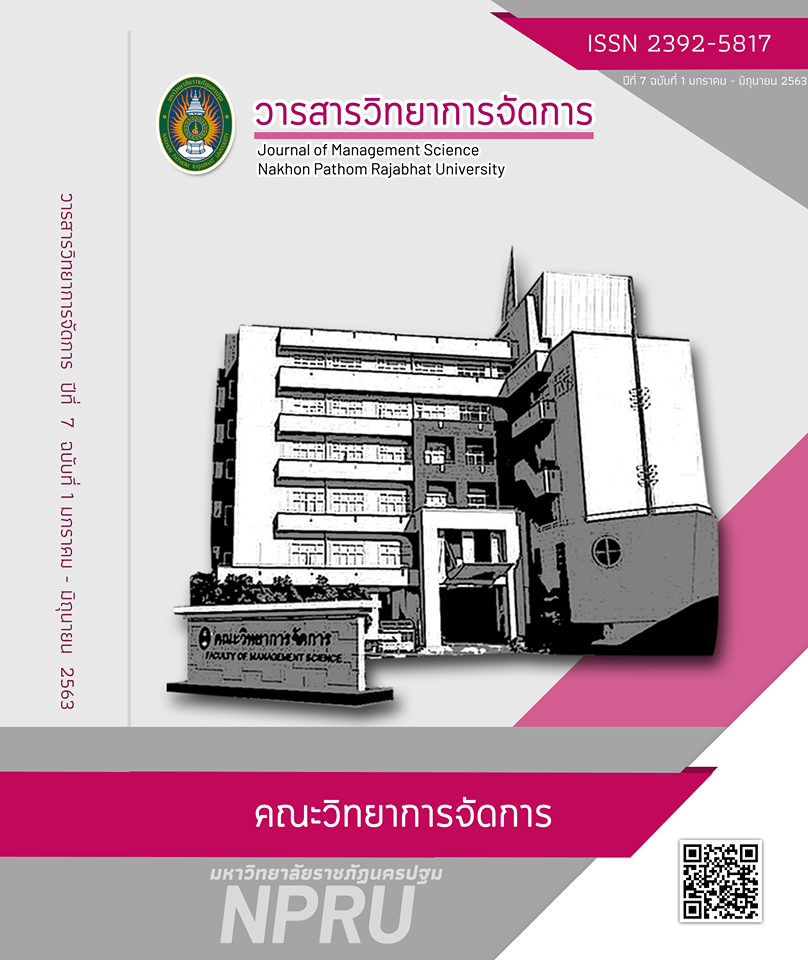Marketing Strategies Effecting To Product Buying Behavior Of Chinese Tourists In Chinatown, Samphanthawong, Bangkok
Main Article Content
Abstract
The objectives of this research were: 1) to study Chinese tourists’ opinion towards marketing strategies effecting to product buying behavior in Chinatown area, 2) to compare buying behavior of Chinese tourists in Chinatown area which classified by personal factor, and 3) to study marketing strategies effecting to product buying behavior of Chinese tourists in Chinatown area. Questionnaires were used to collect data from 400 samples and using multi-stage sampling method. The statistical analysis included percentage, mean, Standard Deviation, Independent t-test, One Way ANOVA, Pearson's Product Moment Correlation Analysis and Stepwise multiple analysis.
The finding showed that:
1.The overall of marketing strategies were in high (Mean =4.09,S.D.=0.25) by focus of the presentation was the highest physical appearance. The study of decision making to buy products showed the most of them have been visited 2 times for the purpose of enjoyment, have a partner / lover traveling, the recognition of information from the internet and the cost per time was 2,001-5,000 Baht respectively.
2. The overall of decision behavior were not difference, except career at statistically significant level of .05.
3. The study result of marketing strategies effecting to product buying behavior of Chinese tourists found that the most important factor was product (b = 0.191) marketing promotion (b= 0.142), service process (b= 0.17) and physical characteristics ( b= 0.130). The equation has 11 percentage predictive power and can write the equation as follow:
Y = 3.460**+ 0.191 X1 *+ 0.072 X2 + 0.091 X3 + 0.142 X4 **+ 0.012 X5 + 0.117 X6 **+ 0.130 X7**
4. The suggestion of this research should develop products standard and tourism services for international standard as well as support for basic Chinese communication, which will be very useful and can provide information to Chinese tourists when there are problems or questions.
Article history : Received 20 December 2019
Revised 1 March 2020
Accepted 5 March 2020
SIMILARITY INDEX = 0.00 %
Article Details
The views and opinions of the article appearing in this journal are those of the author. It is not considered a view and responsibility of the editorial staff.
References
การท่องเที่ยวแห่งประเทศไทย. (2560). แผนยุทธศาสตร์การพัฒนาแหล่งท่องเที่ยวของประเทศ พ.ศ. 2560-2564.. กรุงเทพมหานคร: พีดับบลิว ปริ้นติ้ง.
จารุวรรณ มีศิริ. (2553). ส่วนประสมทางการตลาดและรูปแบบการใช้ชีวิตต่อความตั้งใจซื้อจานดาวเทียม DTV ในเขตกรุงเทพและปริมณฑล. การศึกษาเฉพาะบุคคล. บริหารธุรกิจมหาบัณฑิต. มหาวิทยาลัยกรุงเทพ.
ชูชัย สมิทธิไกร. (2561). พฤติกรรมผู้บริโภค. (พิมพ์ครั้งที่ 6). กรุงเทพมหานคร: ศูนย์หนังสือจุฬามหาวิทยาลัย.
ชิว หลี่. (2556). ปัจจัยการสื่อสารแบบปากต่อปากทางอิเล็กทรอนิกส์และปัจจัยส่วนประสมทางการตลาดที่ส่งผลต่อการตัดสินใจเลือกที่พักของนักท่องเที่ยวชาวจีนในเขต กรุงเทพมหานคร. การศึกษาเฉพาะบุคคล. บริหารธุรกิจมหาบัณฑิต. มหาวิทยาลัยกรุงเทพ.
ธีรวุฒิ เอกะกุล. (2543). ระเบียบวิธีการวิจัยทางพฤติกรรมศาสตร์และสังคมศาสตร์. อุบลราชธานี : สถาบันราชภัฎอุบลราชธานี.
นิศา ชัชกุล. (2557). อุตสาหกรรมการท่องเที่ยว. กรุงเทพมหานคร : จุฬาลงกรณ์มหาวิทยาลัย.
น้ำฝน จันทร์นวล. (2556). ปัจจัยที่มีอิทธิพลต่อพฤติกรรมของนักท่องเที่ยวชาวจีนที่มาท่องเที่ยวเมืองไทย. JOURNAL OF SOUTHERN TECHNOLOGY. 6(2), 53-60.
พรสวรรค์ มโนพัฒนะ. (2553). อุตสาหกรรมการท่องเที่ยวเบื้องต้น. (พิมพ์ครั้งที่ 8). กรุงเทพมหานคร : โรงพิมพ์มหาวิทยาลัยกรุงเทพ.
วาสนา อินทะแสง. (2559). พฤติกรรมผู้บริโภคและปัจจัยส่วนประสมทางการตลาดของธุรกิจคลินิกเสริมความงามที่ส่งผลต่อความภักดีของลูกค้า.การค้นคว้าอิสระบริหารธุรกิจมหาบัณฑิต,มหาวิทยาลัยธรรมศาสตร์.
วรสุดา สุขารมณ์. (2552). ความร่วมมือระหว่างองค์การในการพัฒนาอุตสาหกรรมการท่องเที่ยวไทย. ดุษฎีนิพนธ์รัฐประศาสนศาสตรดุษฎีบัณฑิต. มหาวิทยาลัยรามคำแหง.
ศิริวรรณ เสรีรัตน์ และและ สมชาย หิรัญกิตติ. (2550). การจัดการและพฤติกรรมองค์การ. กรุงเทพมหานคร : ธีระฟิล์ม และไซเท็กซ์.
สำนักงานเขตสัมพันธวงศ์ กรุงเทพมหานคร.(2561). ข้อมูล เขตสัมพันธวงศ์. [ออนไลน์]. ค้นเมื่อ 10 ตุลาคม 2561, จาก http://www.bangkok.go.th/samphanthawong
แสงเดือน รตินธร (2555). ปัจจัยผลักดันและปัจจัยดึงดูดที่มีผลต่อนักท่องเที่ยวชาวจีนในการตัดสินใจ มาท่องเที่ยวในประเทศไทย. วารสารวิชาการสมาคมสถาบันอุดมศึกษาเอกชนแห่งประเทศไทย, 18 (1).84-104.
Agranoff, R. (2006). Inside collaborative network: Ten lessons for public managers. Public Administration Review. 61(63), 57-59
David F.R. (2007) .Strategic Management. Concepts & cases. (3rd ed.) New Jersey: Pearson Prentice Hall.
Katsioloudes, M. I. (2006) . Strategic Management : Global Cultural Perspectives for Profit and Non-Profit Organizations( 2th ed.) . Butterworth-Heinemann.
Kotler, P. (1997). Marketing Management Analysis, Planning, Implementation, and Control. (9th ed.). Prentice Hall, Upper Saddle River.
Mondy, R. W. (2008). Human Resource Management. (10th ed.) Upper Saddle River, New Jersey: Pearson Prentice Hall.
Osborne, S.P. (2010). The new public governance: Emerging perspectives on the theory and practice of public governance. New York : Rout ledge.
Vangen, S., and Huxham, G. (2010).Managing to collaborate. New York : Routledge.


